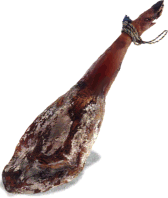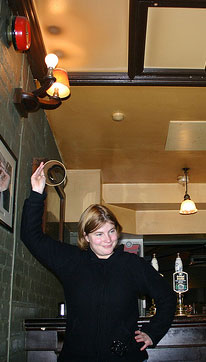I took advantage of the jet-lag to upgrade WordPress at 5am this morning. Please let me know if you find any bugs, blips, blops, or bloopers.
Comforts of home
 We’re home and happy to be here. Although we didn’t fall to our knees and kiss the ground upon landing, we did nearly kiss the cashier at Sparro’s in the airport, which sold several varieties of vegetable-laden food. In the heady postprandial bliss that followed, we sung several verses of “Proud to be An American (‘cause at least I know I’m Free)” and, after finding Advil, Sudafed, and Nyquil on sale at the newsstand, nearly joined the Armed Forces.
We’re home and happy to be here. Although we didn’t fall to our knees and kiss the ground upon landing, we did nearly kiss the cashier at Sparro’s in the airport, which sold several varieties of vegetable-laden food. In the heady postprandial bliss that followed, we sung several verses of “Proud to be An American (‘cause at least I know I’m Free)” and, after finding Advil, Sudafed, and Nyquil on sale at the newsstand, nearly joined the Armed Forces.
Owl the cat was so happy to see us that he immediately fell over. He’s been purring for about twelve solid hours.
I apologize for the disturbing picture in the last post. The greasy keyboard made me do it. Those legs really do hang in every restaurant, bar, and grocery store in Spain, though. Just to remind you that yes, you are eating pig. This pig. Here he is. Say what you will about the soylent greenishness of the U.S. attitude toward meat, I’m not sure hanging desiccated corpses around is a compelling alternative.
Ooh, A Prairie home companion is at my alma mater Michigan State University tonight. Yay!
Spain update
 Hi all – a quick update. I don´t want to type much since I´m using a cybercafe machine and the keyboard is greasy, perhaps due to the monumental consumption of pork products in this country. Great XForms tutorial this morning at the conference. I learned a whole lot about XHTML 2.0 as well. This is some damned exciting stuff for libraries and the library-ness of the web. I´ll try to talk some more about XHTML2 when I´m not dizzy from Spanish over-the-counter cold medicine.
Hi all – a quick update. I don´t want to type much since I´m using a cybercafe machine and the keyboard is greasy, perhaps due to the monumental consumption of pork products in this country. Great XForms tutorial this morning at the conference. I learned a whole lot about XHTML 2.0 as well. This is some damned exciting stuff for libraries and the library-ness of the web. I´ll try to talk some more about XHTML2 when I´m not dizzy from Spanish over-the-counter cold medicine.
Right now I´m going to stay away from the complicated topics and just wish everyone in Los Estados Unidos a happy Thanksgiving. Wish I was with you eating stuffing instead of sitting in a weird cybercafe looking at a pig leg and inhaling secondhand smoke. Good times. I´ll see you all on Saturday back at home.
Liveblogging Fundamentos Web 2005: Part Two
One of the big questions I have about web design for accessibility is, how can I design for one audience without isolating another? Obviously, there are basic things I can do to make our web applications more accessible, by including alt tags, skiplinks, and labeling form fields. But our users have a higher level of disabilities than most due to the nature of our content (birding is of wide interest to the blind and our users are often older, and therefore more likely to have disabilities) and I want to make sure our site is as useful to as many people as possible.
The problem is, if I take steps to make the site accessible to one group, say our partially-sighted users (hi dad), by increasing the text size and contrast, I risk not serving users with cognitive disabilities who respond better to an interface in which only the important elements are emphasized using contrast and the text is not large and overwhelming. Similar arguments apply to designing for young users, who are also one of our main user groups.
The terrible reality is, some solutions can help people with certain disabilities, but exclude others. This puts organizations in a position where they must, often not consciously, choose only certain disabilities to address, such as the charismatic blind man with a dog, and ignore users with different and perhaps competing needs.
I can see why the process of creating web accessibility guidelines is so difficult. The perspectives involved are broad and often divergent. This isn’t like web standards, where you can just close your tags and call it good. Real people will be discriminated against if you screw up. The responsibility is sobering.
At the Macaulay Library, we are proud to provide spectrograms of our bird sounds that are accessible to the hearing-impaired. However, the software to view the spectrograms requires a multimedia plug-in that is annoying to blind users.
What should I do? Do I assume blind users aren’t interested in these spectrograms, and design an interface using Flash and other inaccessible technologies? What if a blind user wants to show a spectrogram, which is a valuable educational tool, to a sighted friend or their child? Even worse, it isn’t possible to even generate spectrograms without using QuickTime and Flash, so the choice has been made for me. Without even making a choice, I’ve created some happy deaf people, and some pissed off blind people. Can I provide an alternative way for the blind to use this feature? Nope. The technology prevents it. Can I provide a larger version of the spectrogram tool for users with manual mobility problems? I could, but it would hold back the entire project while I designed it and no one would be able to use it.
These are dark choices, my friends, and they are often made under pressure of time and money. I’m glad to have the opportunity this week to spend time thinking about them. Thanks to work for sending me here.
Liveblogging Fundamentos Web 2005: Part One
 The conference is in a combination of English and Spanish, with simultaneous translation headsets, so there’s a strange aural halo of chatter going on in the background. I’m providing my own simultaneous translation by blowing my nose every five minutes or so. Stupid cold.
The conference is in a combination of English and Spanish, with simultaneous translation headsets, so there’s a strange aural halo of chatter going on in the background. I’m providing my own simultaneous translation by blowing my nose every five minutes or so. Stupid cold.
Right now John Slaton from the University of Texas Accessibility Institute is speaking. I got a chance to speak with him for a few minutes before the presentation and was glad to hear about his work. I wish more Universities would have this kind of focus on making materials available to everyone. Granted, universities are much better at this sort of thing than most institutions. There’s usually an office somewhere, often in the basement of the library, which helps students with disabilities. Still, it’s neat to hear from a school that has taken a national role in developing accessibility standards. Hook ‘em horns.
Much of what we’re hearing right now from the W3C is "real soon now" about their next set of accessibility standards. Which is understandable considering the scope of this project. It sounds like there is a good understanding of the weaknesses of the current standards, especially regarding new and different combinations of technologies. The old standard assumes you are using just HTML, which is actually fairly unusual these days for large dynamic sites. At my library, we’re using Java, JSP, Struts, and some nonessential JavaScript. All of these languages are pretty tangential to the existing guidelines. There might be a new working draft announced tomorrow. Pretty cool. These are good folks, give them a break.
Dark night of the soul
Hi folks. It’s five am here. I’m in Gijon, Spain. It’s the morning before my conference and my cold has gotten worse. I went to La Pharmacia yesterday and tried to secure something to make my nose stop running. Medicine here is weird. I don’t recognize anything. There’s all this herbal and homeopathic stuff, and when I described my symptoms to the nice pharmacist she gave me the Spanish equivalent of Alka-seltzer with vitamin C. I’m at the point where I would sell my cat for some Advil Cold and Flu. Oog.
Spain! Ham!
Spain!
Thanks to the noble efforts of our catsitter friends, the famous librarian-and-animal scientist couple Clay and Mike, our tickets to Spain arrived safely, and we spent six public transportation-filled hours in Madrid while we waited for our train to the north.
This might come as a surprise to some of you, but Madrid? Not a town for vegetarians. Within two blocks, we passed El Museo de Jamon, and Palacio de Jamon. Yes, that’s the Museum of Ham, and Ham Castle. Madrid was beautiful and huge and weird. We did a quick tour through la Plaza del Sol while searching for food. As the default sometimes meat-eater, I ended up consuming all things mysterious that arrived at our table. Which pretty much ended up being everything. We kept ordering things that seemed vegetarian, and they kept arriving covered in ham. Chris ended up eating a bocadillo and some cheese we brought from the UK.
The best library-related thing about Madrid was the Amazingly Clever and Fabulous Biblioteca Metro – sort of a bookmobile kiosk in one of the subway stations. It was charming, modern, well-designed, and the librarian helped us figure out the difference between commuter trains and metro trains. Sadly, we didn’t get a photo of it (or one of Ham Castle) because travel rule number one is: Sleepy people shouldn’t bring expensive digital cameras that they don’t own into downtown Madrid on a Friday night. So you’ll just have to imagine it. Mmm.
We couldn’t get a sleeping car to our conference in Gijon because they were all going to Bilbao, so we ended up sleeping in the brightly-lit second class compartment with our feet on our bags and cricks in our necks. Our guidebook, which shall heretofore be referred to as The Big Book of Paranoia, convinced us that every third person was a pickpocket, so that didn’t help with the sleeping. This morning was a blur, spent trying to speak enough Spanish on .2 hours sleep to convince the kind hotel lady to give us una cama de no fumando. We have now learned that the process of preparing a no smoking room in Spain involves removing the ashtray and spraying Drakkar everywhere.
Still, this may be the best hotel I’ve ever stayed in. I want the hotel decorator to come and visit my house immediately. Everything is modern and minimalist and ergonomic and just so not British. It’s Hotel AC Gijon. It’s a chain. I unhesitatingly recommend it, and not just because they gave us our rooms at 7am on a Saturday, when every sensible Spaniard is home with a hangover.
We to took a long hike around the city center this afternoon and walked along the sea, then returned to the hotel exhausted. Chris took gobs of photos of la Biblioteca Gijon for your viewing enjoyment. They have a cute and comfy reading room filled with middle aged men reading the newspaper.
We watched Pedro Almodovar’s Carne Tremula tonight on one of our laptops and now appreciate Madrid even more. I think this is one of Almodovar’s most accessible and least creepy films. If you want to check out a great piece of Spanish cinema but don’t want to yell “Oh God please don’t do what I think you are going to do” every five minutes, then this is the film for you.
Hi to everyone. I just read my London comments today and am Really grumpy to have missed the Women’s Library. But we also missed Westminster and The tower, thanks to some bad info about closing times. I also planned to become a reader at the British library, but we didn’t have time to return. So, feh. We’ll be back. And next time I’m bringing my 12 postgraduate degrees so I can stay.
Burning down the pub
Today was rough. We both caught colds from running around in the chilly weather. Rick Steves lied about Westminster’s winter hours, so Chaucer’s grave remains unheralded by me. We did spend way too much time in the British Museum, which as far as museums go, could do more with the interpretation and less with the pile-everything-in-one-huge-room-and-let-’em-at-it. Now, I love me some world history, but after the 2300th cuneiform engraved tablet, I was ready for something new.
Now, I love me some world history, but after the 2300th cuneiform engraved tablet, I was ready for something new.
Which we found in a fabulous pub called Ye Olde Cheshire Cheese, located in the financial district in old London. It’s been standing since the 1600s and has character oozing out of the walls. Also oozing out of the walls were several dozen young lawyers. We kept our distance and had great beer.
At one point, we saved the pub from burning down. The lights had these tiny paper shades, and after a pint or two, we noticed that the light-shade nearest us was smoking. It had fallen down and was touching the bare lightbulb. Small circles of burn were starting to accumulate on the ceiling. Chris removed it and I mentioned it to the bartender. So if the place catches fire, It’s NOT OUR FAULT.




